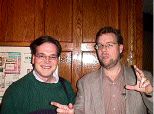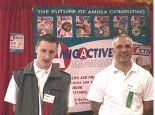
The Amiga Is Back!
a show report from St. Louis
This year's Amiga2K trade show in St. Louis, Missouri, featured the unveiling of the new Amiga Developer Reference Platform as well as a more detailed look at Amiga's partners and plans. Presentations spearheaded by Amiga CEO Bill McEwen, VP of Development Fleecy Moss, and Director of Developer Support Gary Peake outlined Amiga's goal to create a digital environment that is scalable as well as transparent to those interested in the future of digital content.
The show itself featured the usual gathering of Amiga personalities, developers, vendors, and faithful under the expert execution of Bob Scharpe, the show's organizer. In its last year at The Henry the 8th Hotel, the Amiga2K show has become North America's premiere Amiga event. Highlights included the first official Amiga developer conference under the new company, an informative meeting between McEwen and user group representatives, and the formal presentation at the show's banquet.
A Three-Hour Tour
The Friday night before the show, Amiga held its first official DevCon complete with non-disclosure agreements for those in attendance. A good mix of prominent Amiga developers, shareware programmers, and personalities were on hand to hear specifics of Amiga's partnerships, details on the "Ami" programming model, and an outline of Amiga's developer support program. The presentation was quite detailed and lasted three and a half hours.
After a brief introduction by Bill McEwen, Fleecy Moss led things off with a quick rundown of Amiga's vision concerning the future of digital convergence. Moss explained how Amiga is harnessing cutting edge technologies and bringing them into an Amiga environment that is designed from the ground up to exploit digital content. He emphasized that Amiga is uniquely qualified to unite the talents from the Amiga, Linux and Java programming communities and they will do this by combining technology elements from their partners and joining them within an Amiga environment.
Important to Amiga's plans are the partnerships forged by Amiga with TAO-Group, Sun, Red Hat, and Corel. With the growing number of Linux distributions and their growing incompatibilities, Amiga will present programmers with a common consumer layer to attract their support. The Ami environment will significantly reduce deployment of applications and content due to Amiga's partnerships and the integration of TAO's Elate software into the Amiga environment.
The Amiga environment uses TAO's Elate as a foundation. A main feature of Elate is its Virtual Processor (VP) programming model. Instead of concerning itself with the hardware underneath, Elate uses massive abstraction that presents the operating system with a dynamic list of services it will provide based on the hardware below it. These services will then fulfill the requests of the applications above it by arbitrating them. (Please see 'Inside The New Amiga' and 'Entering The AmiVerse' for more details).
Moss emphasized that with hardware being treated as a commodity--and citing Be Inc.'s problems with providing drivers for even common items--it was more important to provide programmers with a quick and flexible environment. Because Amiga found a way to combine the best technologies within the Amiga environment, flexibility is achieved. With TAO's Virtual Processor, a programmer can truly compile once and run anywhere. The list of supported VP interpreters includes X86, MIPS, PowerPC, ARM, StrongARM, MCore (Motorola's new embedded CPU of choice), and a growing list of others.



To get programmers familiar with Virtual Processor programming as soon as possible, Amiga announced the details of the soon to be release Developer Reference Platform (DRP). Hosted on a special version of Red Hat Linux, the machine will feature an AMD K6-II 500 MHz CPU, a GeForce Prophet 3D video card, a Soundblaster compatible sound card, 64 megs of RAM, and TAO's Elate software preloaded.
Some points on the DRP should be noted. First, Amiga chose to use less then cutting edge hardware in the DRP to emphasize just how efficient their environment will be. This also reduces the cost of each unit. Second, the Ami environment will be preloaded on all Developer Reference Platforms. This prevents pirating (Amiga will only support developer machines purchased directly from them). Third, while the DRP is hosted on Linux and a X86 processor, Amiga consumer products will most often be run natively--not hosted on another operating system--and therefore, will run much faster then they do on the initial DRP.
Gary Peake outlined a multi-tiered Amiga Developer Support Program. The upper layers of this program will be fee based depending on that company's scope of business. "Premiere" developers will pay to receive Amiga's most responsive level of technical support and assistance, while on the lower end a "Scouts" membership is free and tailored more to the valued "bedroom" programmers. All levels of support will require a signed NDA with Amiga, and will allow access to Amiga's developer materials and website. Important Amiga related organizations like the Amiga Advisory Council, Industry Council Open Amiga, and Phoenix Consortium will also play a role in developer support. Amiga also announced there will be five more DevCons this year, and invited all interested parties to register and attend.
For the Community
On Saturday afternoon Bill McEwen met with various user group organizations. The discussion led off with Gary Peake, Wayne Hunt and other representatives discussing the state of Amiga user groups as well as the possibility of sharing resources like newsletter articles between organizations. Amiga plans to use organizations like Team Amiga and the User Group Network (UGN) to enhance the user's experience. Amiga also plans a user group tour to demonstrate the new Amiga technology directly to user groups.
McEwen reiterated that the Amiga community was the reason that he bought the name and, because of the dedicated users, the Amiga still has great value. He encouraged the user community to contact Amiga for assistance in their endeavors. For example, Amiga is willing to partially sponsor local children's sport teams and advertise in user group publications. To take advantage of this user groups should contact Kari at Amiga. Amiga also plans to refer certain inquires back to the local user groups using the UGN's user group database. A substantial portion of Amiga's future marketing staff will implement plans that utilize user groups for their success. Lastly, Amiga will provide publications like Java Programming books through the developer and user group communities. Through deals negotiated with Sun, these publications will be available at cost.
To assist in the transition to the new technology based products next year, Amiga will lower the cost of the existing Amiga 1200 inventory (there are plenty of PAL units left, but not that many NTSC units). These A1200s, along with the new PowerPC accelerators, will allow Amigans to use the current technology as well as benefit from the new Ami environment when it's released. While Amiga is exploring the manufacturing of more A4000 units (and supporting the Boxer), there are no plans to restart A1200 production.
Dinner with Dick Van Dyke
The highlight of the Amiga2K show was the banquet dinner on Saturday night. After the meal, McEwen presented show organizers Bob and Diane Scharpe with some nice Amiga Bomber Jackets in gratitude for their efforts. The presentation continued with a video that featured actor Dick Van Dyke; who turns out to be a long time Toaster/Lightwave fan. Van Dyke expressed his optimism for the Amiga and its future and raved about his Amiga's video and animation capabilities. In closing, the famous actor expressed his eagerness to see the new Amiga based products and wished the crowd well.


The partners Amiga is working with are the cornerstones to Amiga's future. Besides Corel, Sun, and Red Hat, McEwen included other major consumer company names like Sony, JVC and Criterion. He also included familiar companies like Scala, Met@box, Haage & Partner, Hyperion, and Anti-Gravity. Anti-Gravity is of particular interest because they recently announced their purchase of the Boxer design from Access Innovations and hired the board's designer Mick Tinker to finish its development.
Amiga's goal in the scalable consumer appliance model is to function as the common programming interface. Their partnerships with Corel and Red Hat in particular will allow Amiga to hit the ground running using the Linux kernel and device drivers. McEwen used quotes from Sun's Bob Young and Corel's Michael Cowpland to emphasize their eagerness to be part of the Amiga revolution. Also on hand at the presentation was a representative of Espial. Amiga is trying to conclude negotiations with Espial to integrate their Java based web browser, called Escape, into the Ami environment.
Amiga proudly displayed conceptual case designs of Amiga-based computers (both tower and desktop), consoles, and servers. These designs were provided to Amiga by animators that worked for Disney on several projects. While it was disclosed that Disney still uses up to 500 Amigas in their production departments, Amiga did not announce Disney as a partner.
Even though Amiga plans to be a software company only, they will provide hardware references to their partners. McEwen also promised that no matter how successful Amiga may become, they would never impede in their partner's market space. Amiga will never make a spreadsheet, word processor, or game; those things are being left up to Amiga's partners.


A demonstration of the Beta Amiga environment was presented at the banquet. The demonstration highlighted the systems capabilities by running several Java Applets simultaneously at good speed. The systems ease of coding was emphasized by demonstrating Doom and Quake which each took less than an hour to port. Advanced video layer technology was also displayed by applying color filters over running demo programs and by showing the ability to present non-square GUI objects. To demonstrate this feature a Boing ball was manipulated through the transparent face of a clock program running in front of the Boing balls. In spite of the fact that the system took a performance hit by being hosted on top of Linux, the demonstrations ran at impressive speeds.
Happy Trails
On Sunday, many of the show attendees were abuzz with the announcements Amiga made the night before. Many of the exhibitors were reporting good sales and optimism in the direction Amiga was taking. As is common in the close-knit Amiga community, news spread quickly to Amiga related websites. Naturally, the quick dissimilation of news was accelerated by a live video and audio stream from the show, compliments of the UGN.
For the next few weeks Amiga will be focusing on getting the Developer Reference Platform out the door, implementing their developer support programs, and working on their Ami environment. You can find further information from the show on Amiga's redesigned website at www.amiga.com.